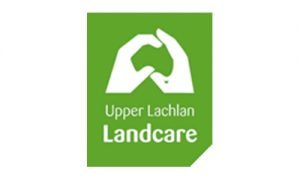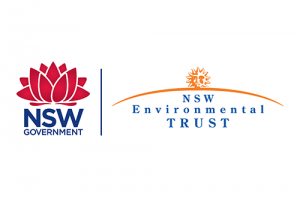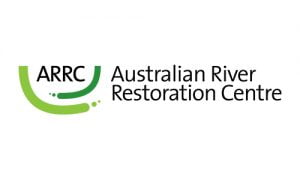One of the pleasures of our work at Rivers of Carbon is having landholders who are keen to collaborate with us to care for waterways. Rod Hoare and Helena Warren are two such landholders. They live on their beautiful property ‘Cadfor’, at Binda in the southern tablelands of New South Wales. We first met them when we were looking for examples of chain-of-ponds for a film we were doing on that topic. Rod restored a chain-of-ponds using a mix of on-ground works and stock management, with his efforts earning him a ‘best landholder in a feature film’ award (see the Buffers, Sponges and Moderators video). Since then, we have continued our work at ‘Cadfor’, and Rod and Helena are now part of our Rivers of Carbon – Grabben-Gullen project.
As you know, at Rivers of Carbon we love stories, so we asked Rod and Helena if they would share the story of ‘Cadfor’, fortunately they said ‘yes’, so here it is for you to enjoy.
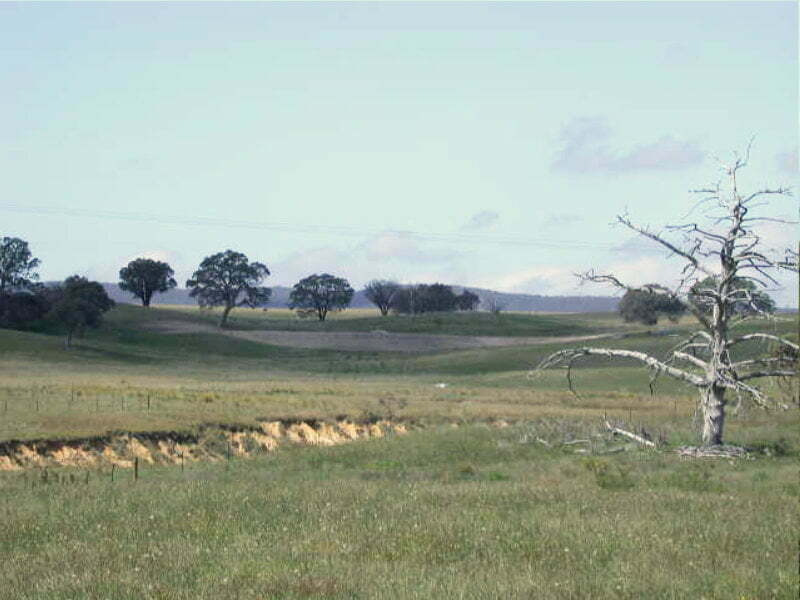
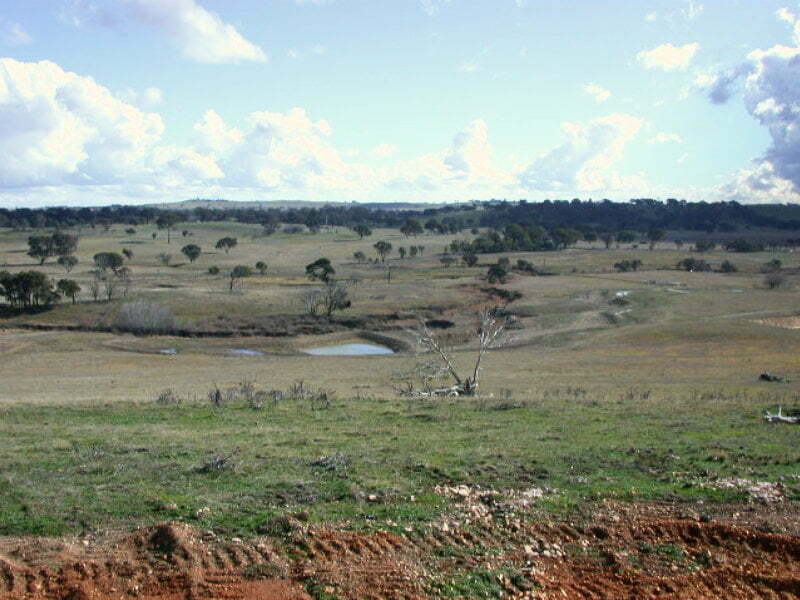

Beginnings
Rod and Helena are both ex NSW Department of Agriculture employees, with Rod a veterinarian and Helena having expertise in nutrition, soils and fertilisers. They lived on 28 acres at Lakesland near Picton from 1995 to 2005, where they ran a herd of stud Murray Greys on the Hoare family farm at Wilton. When the decision was made to sell the family farm, Rod and Helena had to make a decision about whether to stay in the Picton area or move elsewhere. The urbanisation of the Picton area meant that the price of the farm increased while liveability for the family decreased, so the decision was made to sell.
Given their agricultural knowledge, one of the key factors guiding where they would move was reliable rainfall. Rod and Helena knew of the Crookwell area, and due to its climate, ease of access and good soils, it made the top of the list of possible places to live. At the time of looking, mean daily maximum temperatures were around 18.1° C with a daily minimum of 5.0° C, along with the all-important reliable rainfall in winter and spring.
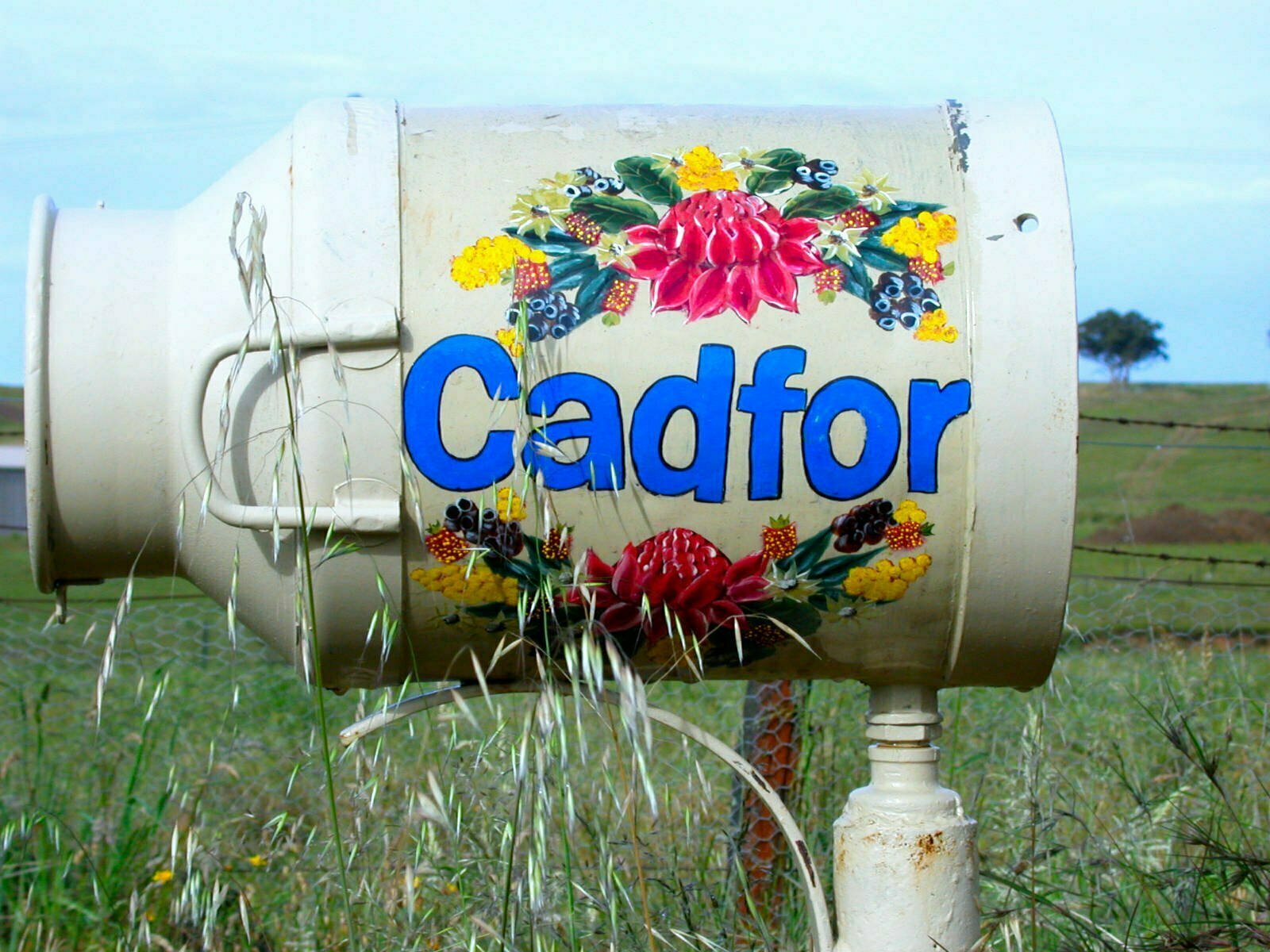
In 2001, Rod and Helena purchased a cheap unimproved farm of 200 acres at Binda. Being an unimproved block, they could set it up as they liked and implement findings from research into sustainable grazing systems for tablelands pastures. They started their development of the farm on weekends, initially staying in a caravan and then in a shed which was to become the workshop. In 2005, following Rod’s retirement, the couple built a solar passive house and moved to ‘Cadfor’ at Binda.

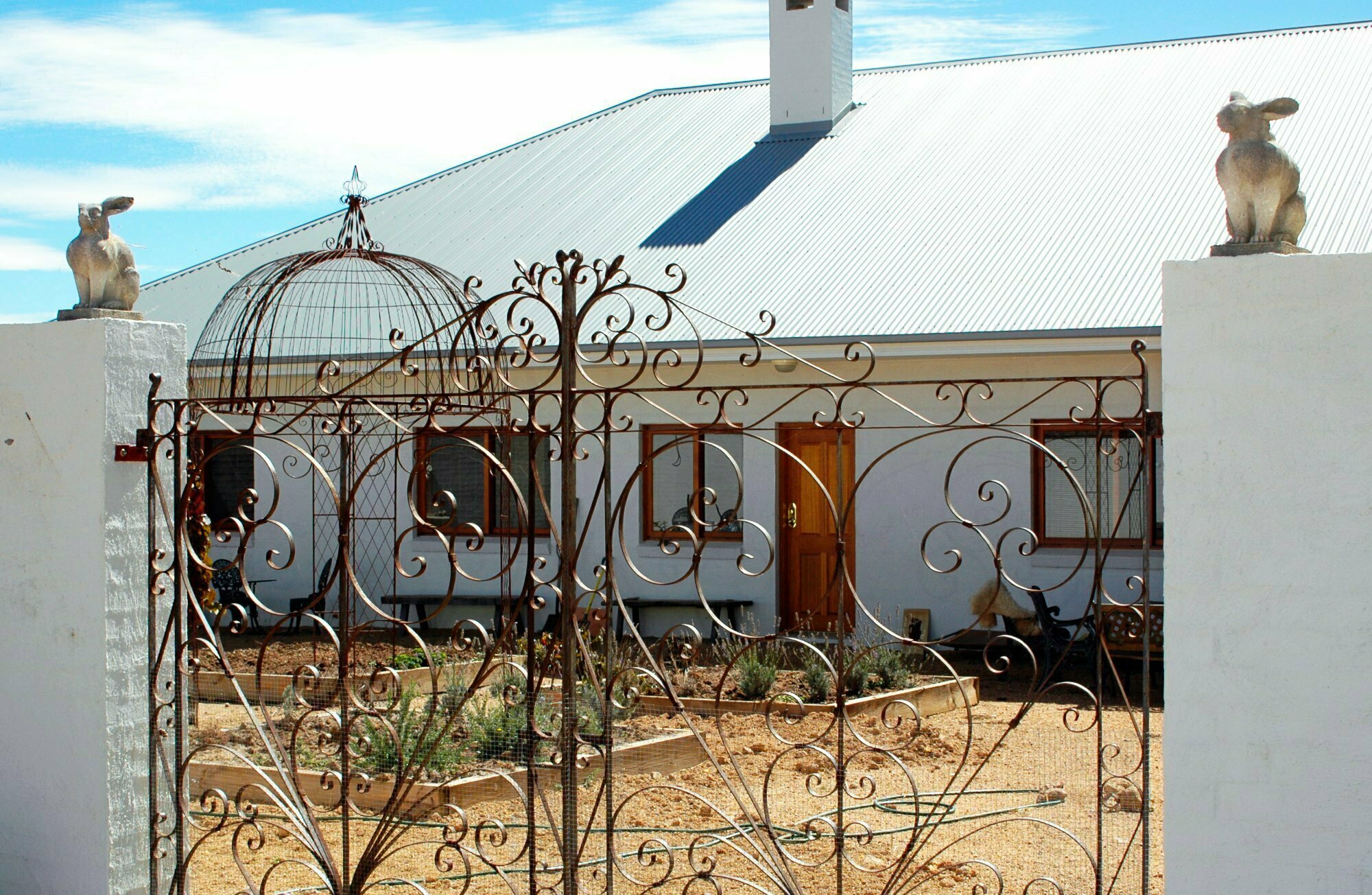
Farm planning
Once purchased, a detailed farm plan was developed to guide economic and environmental activity. The first step was to fence off the highly eroded Binda Vale Creek which runs south to north, the length of the property. Several large erosion gullies were repaired with dams incorporated to slow water down and provide water for stock. A pump was installed on the Binda Vale Creek to supply three tanks on hills, and numerous troughs were put in place to enable the original four large paddocks to be subdivided into 25. Revegetation commenced with tree breaks providing shelter for stock as well as wildlife. Rod used high intensity grazing to retain biodiversity around the creek so that monocultures of kangaroo grass or exotic species could not take hold.
In 2006, Rod and Helena purchased an additional 130 denuded acres adjoining the original block and followed the same farm plan. They fenced off another highly eroded gully which was marked on the maps as the ‘Chain of Ponds Creek’, and it is this part of the farm which features in our Buffers, Sponges and Moderators film. Two large paddocks were divided into ten, and stock water provided through a mix of dams and troughs.
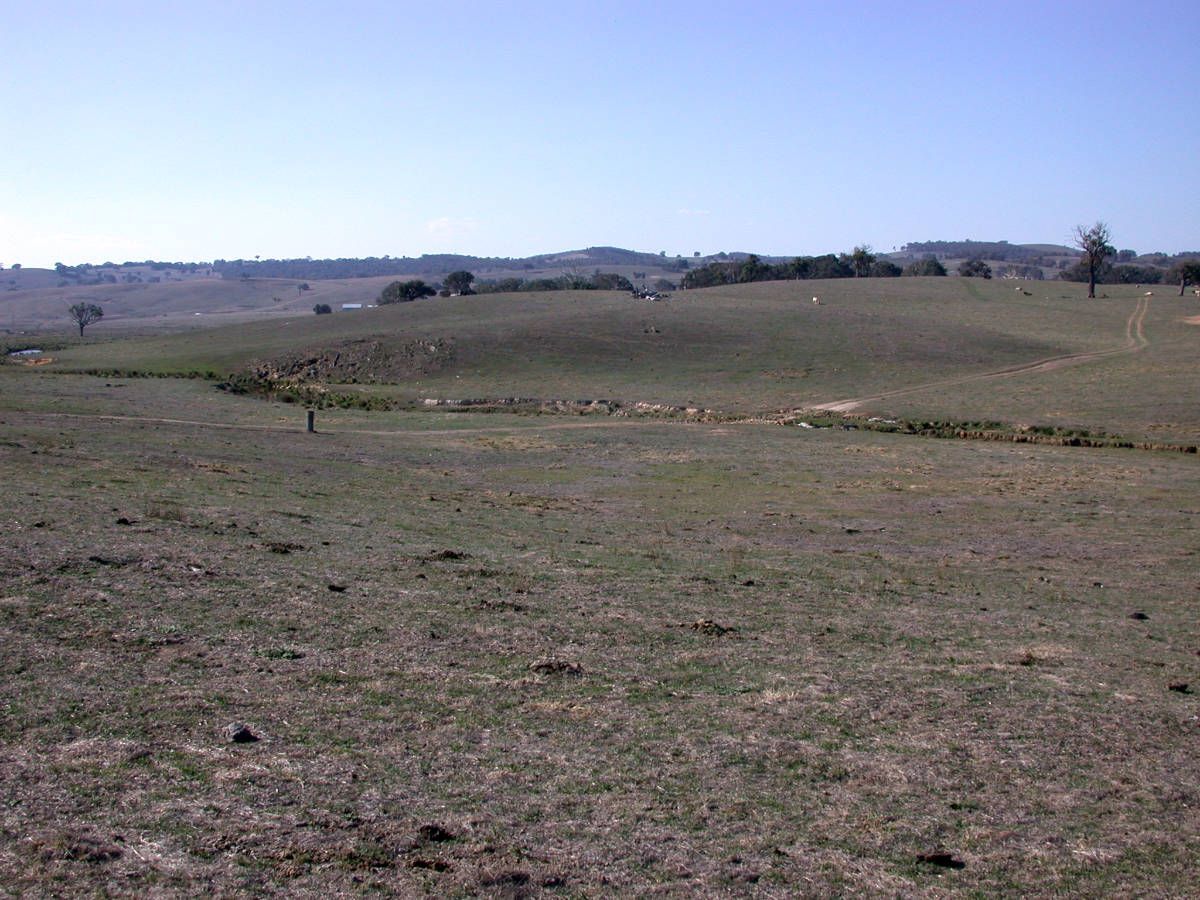
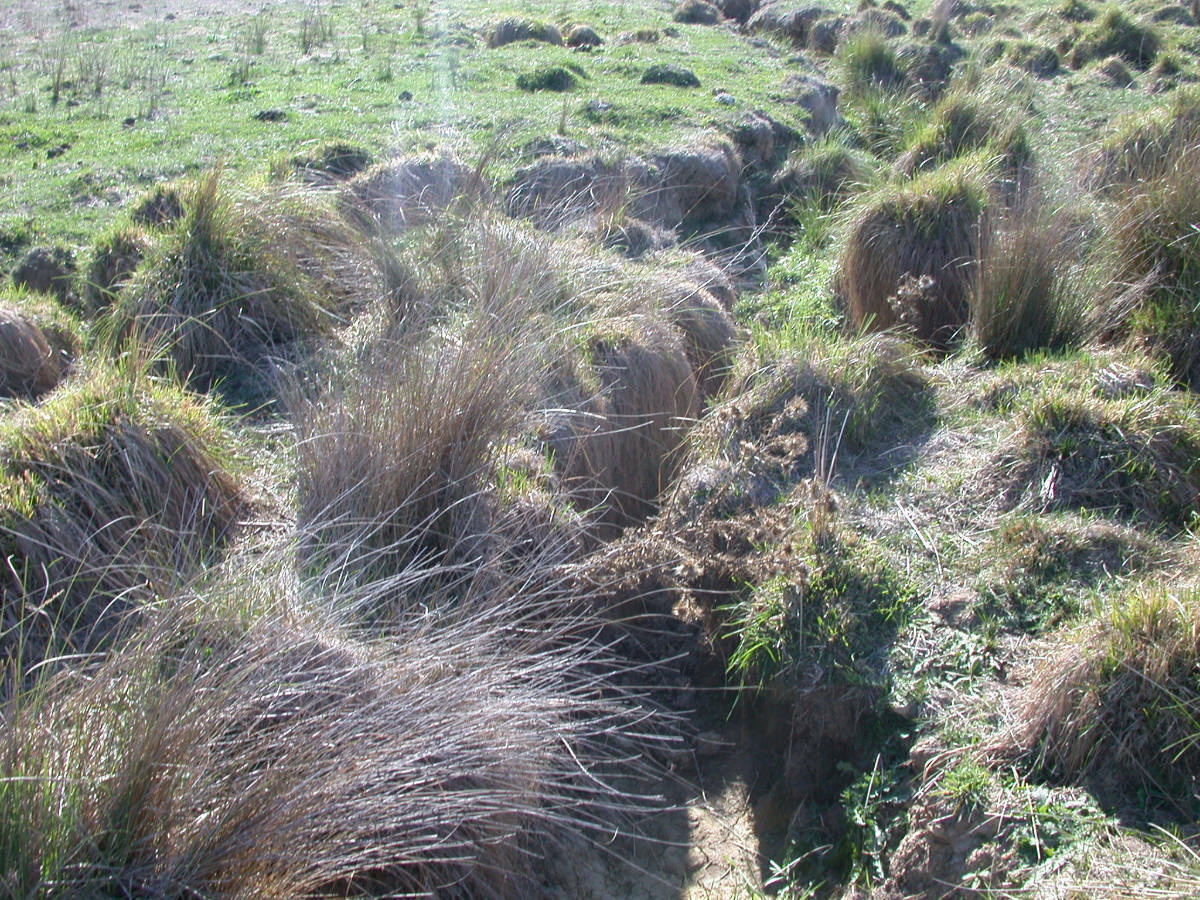
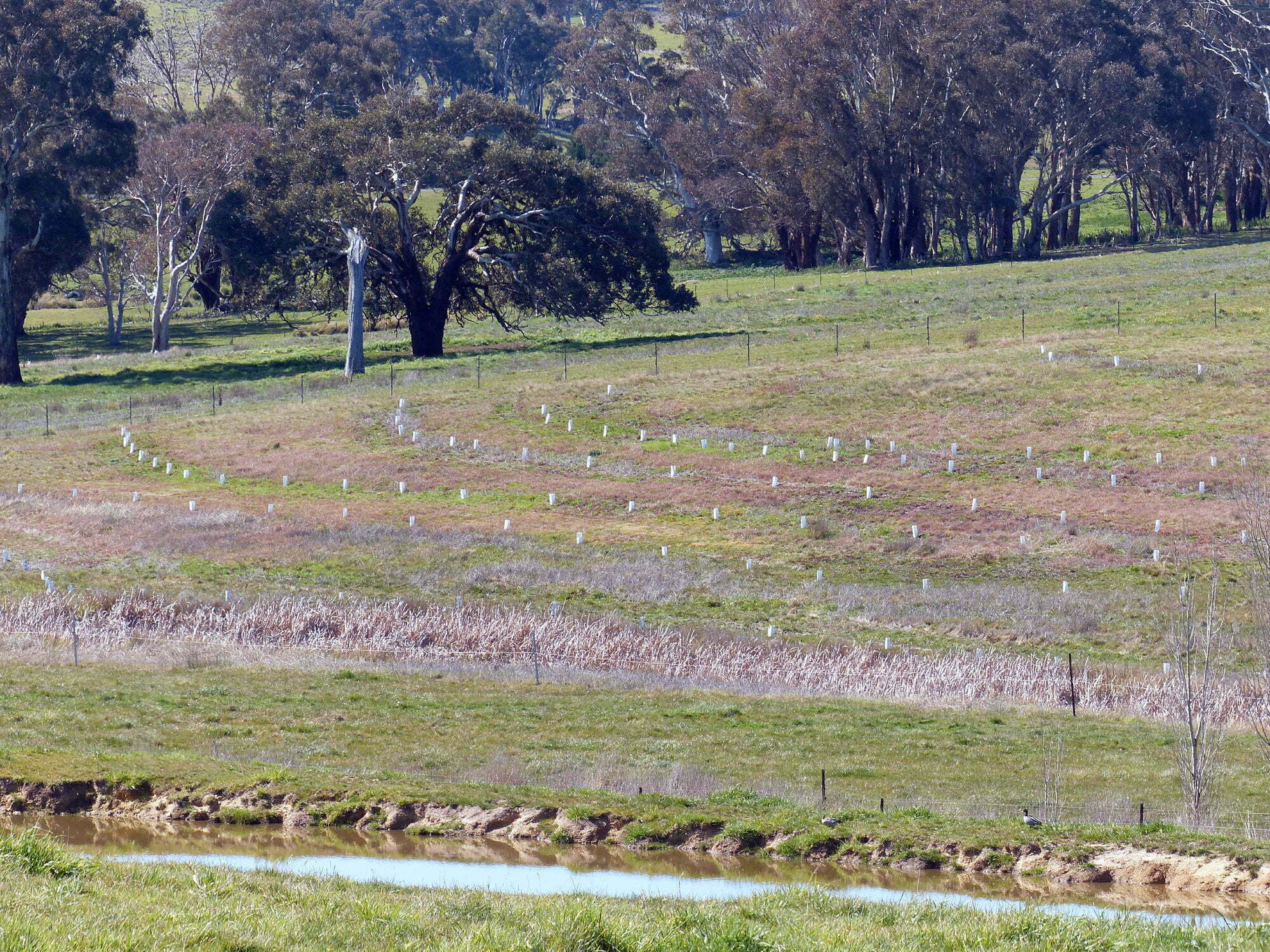
Biosecurity
Biosecurity planning identified noxious weeds such as serrated tussock as the major threat on the property, and this was followed by animal diseases. To mitigate transport of weeds and disease, farm design started at the entrance, with designated gravel areas for cars to park. Trucks and floats are directed to the gravel cattle yard loading ramp and vehicles are checked for weeds. All grass around the parking area is mown and regularly reviewed for weed incursions.
Most of the Cadfor boundaries are double fenced to enhance livestock security and prevent nose to nose contact. Single or twin electric wires have proved adequate to keep cattle off the boundary fence and a three-metre gap enables trees and shrubs to be grown – providing shade, shelter and wildlife habitat. The heavy grass growth in the tree breaks also helps to restrict the entry of weed seeds such as serrated tussock and thistles. Double fencing is also used in much of the internal fencing to aid separation of bulls and mating groups. For the couple’s work on biosecurity Rod was awarded the National Animal Biosecurity Farmer of the Year in 2012.
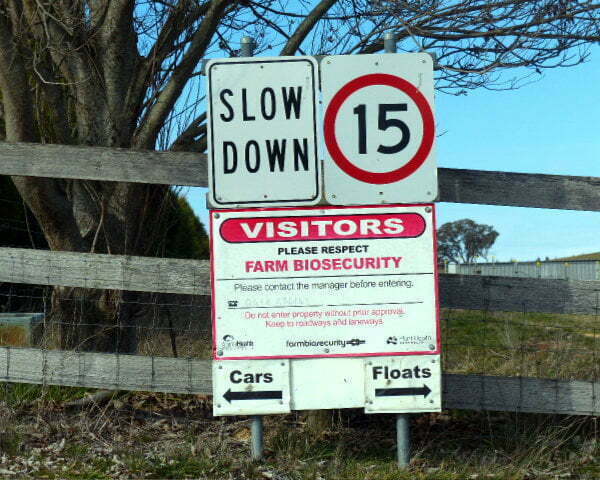
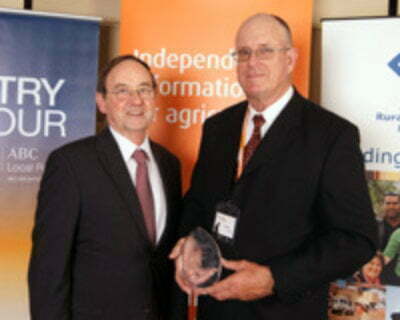
Soils
The western end of the farm has granite based soils, while the adjoining second block purchased has shale based soil. The blocks are either side of a significant uplift called the ‘Binda Thrust’. Initial soil tests showed highly acidic soils (pH 4.1), with very low phosphorus and sulphur. Soil amendments have been applied to increase pH and to correct nutrient deficiencies. The primary fertilizers applied have been poultry manure, lime and gypsum. When specific nutrients were required, superphosphate, potash, sulphate of ammonia and urea have been used. More recently Rod and Helena have been increasing sub surface (10 – 20 cm) pH using lime to maintain surface (0 – 10 cm) at pH 5.5 – 6.0.
Soil carbon levels measured shortly after the property purchase in 2004 were about 2.1% soil organic carbon, and this had risen to 3.4% SOC in 2018. Areas of salinity were identified in southern portions of the newly purchased block, with very low levels of phosphorus and potassium and high levels of magnesium, calcium and sulphur. This meant an overall higher pH levels than surrounding areas. Poultry litter was applied to correct the deficiencies, and fescue and phalaris were sown as they are tolerant of salinity.
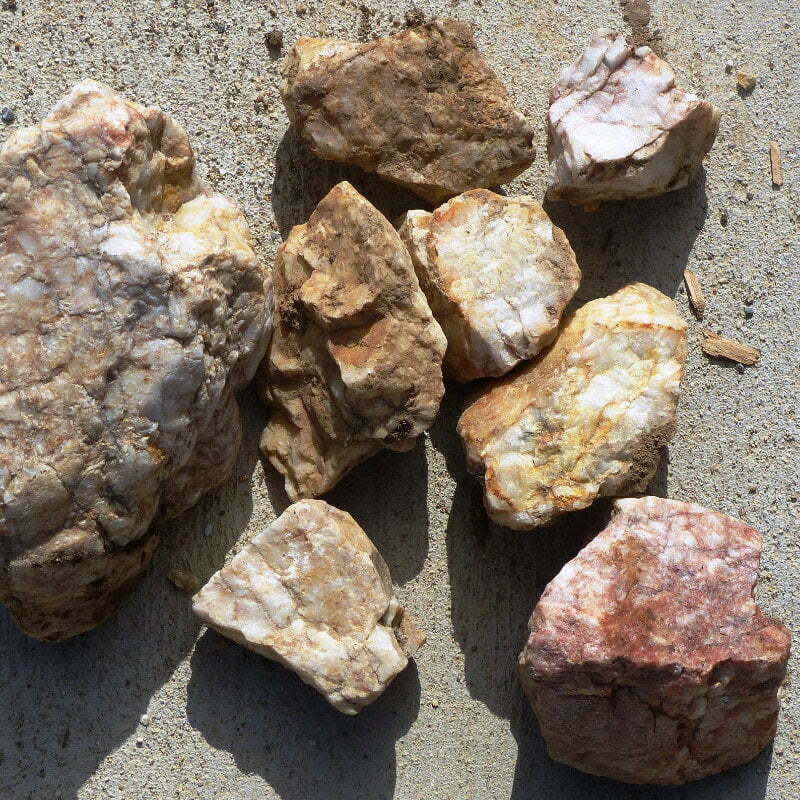
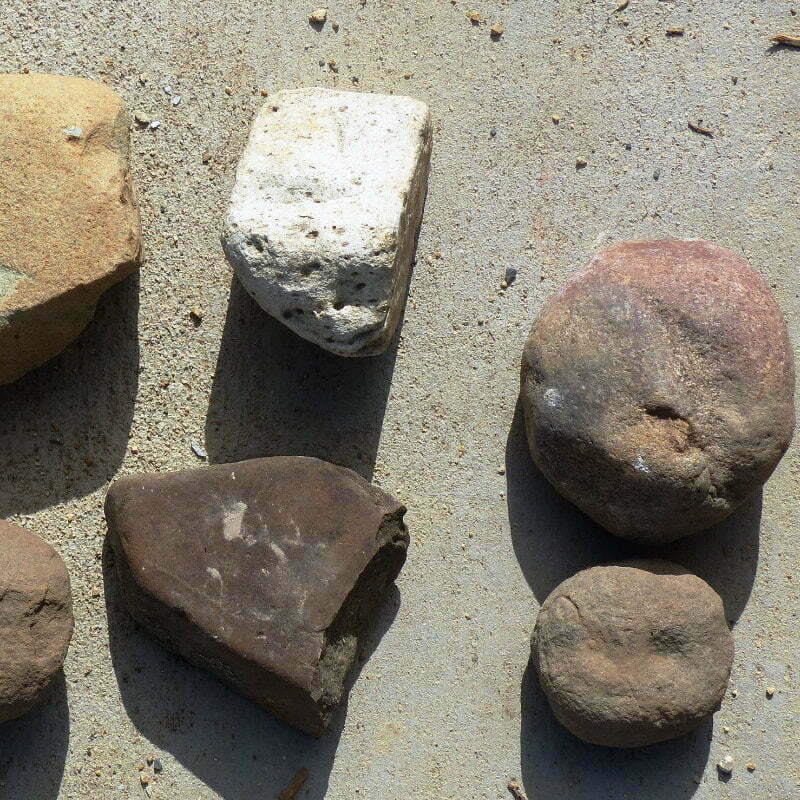
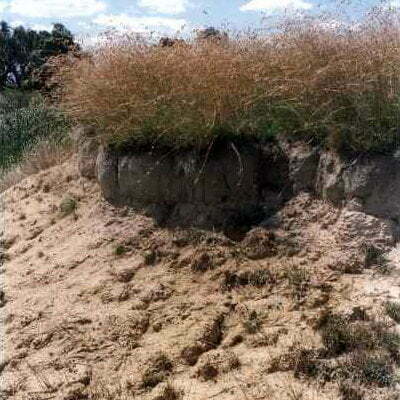
Pasture improvement
Initially, one paddock had a good stand of long established cocksfoot, otherwise the pastures were weedy, with evidence of pasture renovation which had degraded through overgrazing and low fertility. Poultry manure was applied and sub clover became apparent. The improved fertility also stimulated mass germination of Vulpia which was controlled by intensive grazing management. Perennial species were given a competitive advantage with the improved fertility, reduced competition and rotational grazing. Other weeds such as flatweed, sorrel and Yorkshire Fog were reduced with better fertility and grazing management.
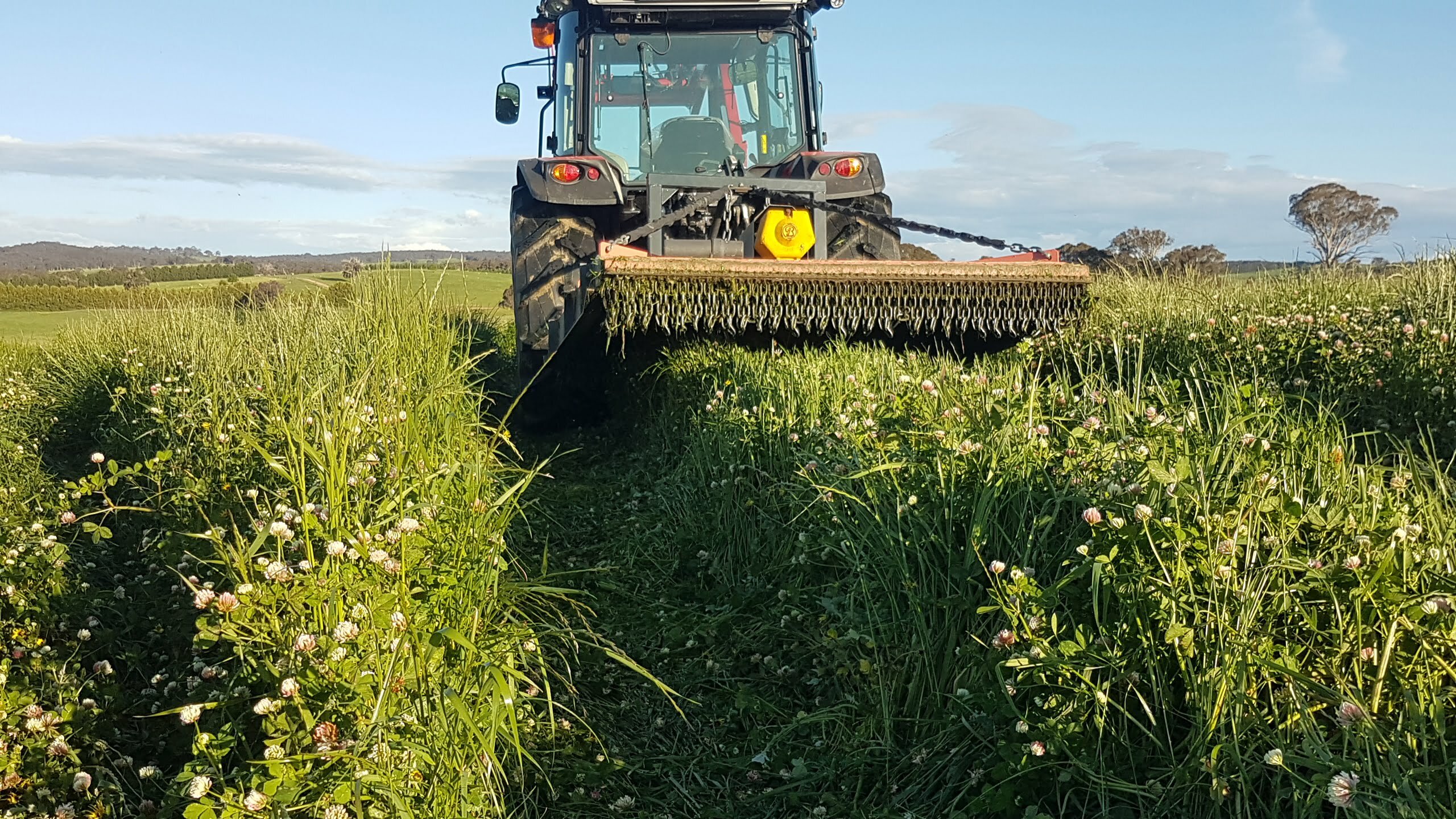
Grazing management
Helena has had extensive experience with grazing management and is a Prograze presenter. She was also, at one stage, in charge of the NSW DPI Feeds Evaluation Service and Technical Manager of the Phosphorus dairy trial conducted at EMAI Menangle. Her knowledge and experience has been used to manage the grazing cattle at “Cadfor” which is based on strategically rotating livestock around paddocks to ensure that plants get adequate rest between grazings. A ‘When Ready Grazing’ strategy is used, which means that the pasture is not grazed until it has recovered. Perennial grasses are assessed as having recovered based on a count of new leaves; ryegrass – 3 leaves, phalaris, cocksfoot and fescue – 4 leaves and kikuyu – 5 leaves. At all times 100% of ground cover is maintained.
Helena and Rod do not follow a rigid timetable of moving cattle at set intervals or in a strict order. At times they will leave paddocks out of rotation if growth rates are high, and other paddocks need to be grazed because they are at their optimum stage of growth. At other times they will ‘Chase the Green’ when some species are in a vegetative phase offering high nutritive value. When the pastures drop in protein the cattle are offered a urea / molasses mixture in roller drums. Urea provides a nitrogen source which assists the ruminal microflora to digest fibrous feeds and enhances the passage of feed through the gut.
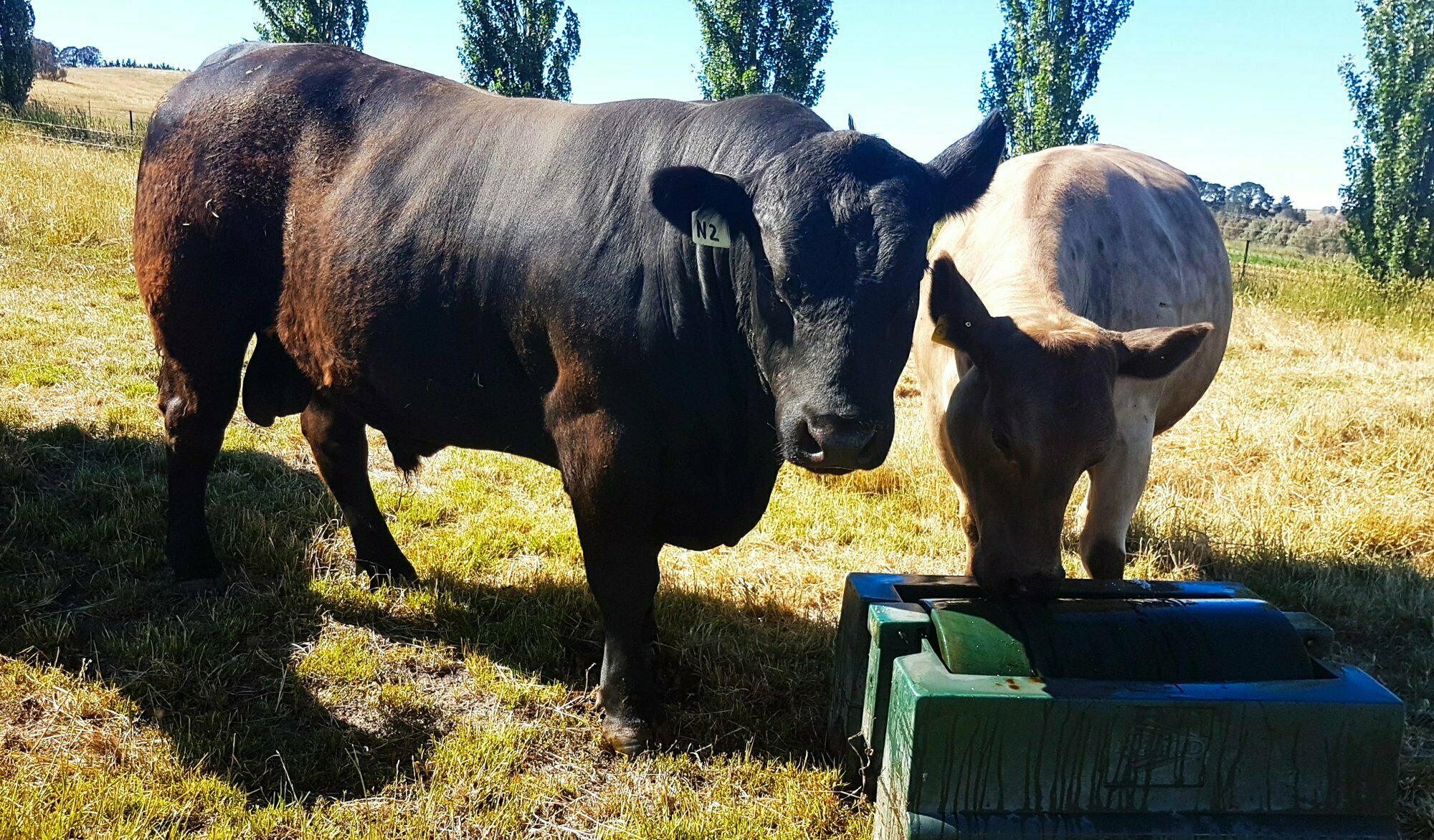
Adapting to climate change
When Rod and Helena first purchased the property, climate change predictions for the region were for increased temperatures, more frequent and intense heatwaves and reduced average rainfall. This was together with increased frequency of extreme weather events such as droughts, floods, unseasonal frosts and summer storms. These predictions are being felt now. The implications are that pasture species such as perennial ryegrass will be less able to survive hot conditions, and summer growing grasses will become more productive.
Water security is a key concern for Rod and Helena who had experienced erratic rainfall when farming at Wilton. All the dams that have been constructed at Binda are deep, and designed to last a three-year drought. Binda Vale Creek, from which water is pumped for stock and domestic usage, is spring fed and only stopped running for a short period in the Millennium drought. A backup source of water is the large dam in front of Rod and Helena’s house.
Hand feeding of cattle is kept to a minimum, with roughage supplements provided in winter and early spring for a month or so. A major reason is to prevent grass tetany or bloat when the feed is low in dry matter or is clover dominant. Their horses are fed hay to reduce the risk of laminitis or founder, with two hay sheds constructed to enable the storage of large square bales. When the seasons are suitable and there is excess pasture, paddocks are taken out of rotation and round bale hay or silage is made.
Shade and shelter is mainly provided by shelter belts, plus some isolated paddock trees. The tree felling undertaken by the original sawyers, the Hone family, means that some paddocks have poor or limited shelter. Rod and Helena keep a close eye on the weather and move stock into sheltered paddocks when snow or heat waves are forecast.
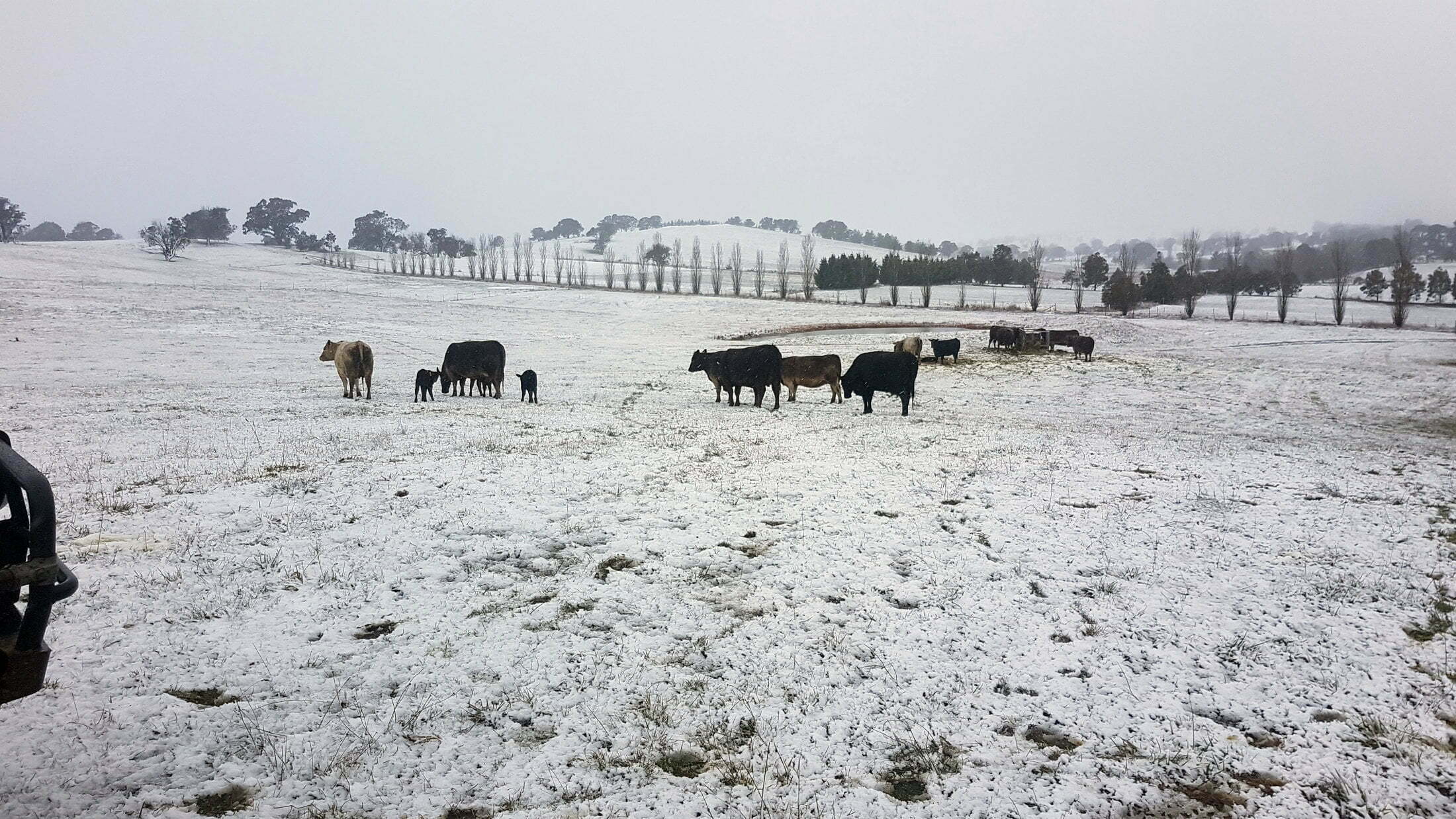
Cattle
Rod and Helena’s stud ‘Cadfor Murray Greys’, has achieved National and International recognition. Semen from their bulls has gone to all states, and semen from ‘Cadfor Genesis’ has been used in New Zealand, United Kingdom European Union, South Africa, as well as North and South America. The cattle are shown in the commercial (unled) section of Crookwell Show and since they started competing in 2010 their stock have won Champion Murray Grey Female 8 times, Supreme Commercial or Prime Exhibit 6 times, Champion Vealer 5 times and the Lake Edward Trophy 3 times. They have also exhibited steers in carcase competitions. In 2019 and 2020 Rod and Helena exhibited the Grand Champion carcase in the South Coast Schools Steer Spectacular. In 2020, their steer scored 99 out of 100, the highest score recorded and the steer was described as ‘near perfect’. In 2021 their steer was awarded Champion Middleweight Carcase.
All cattle details are recorded on Cattlelink software which provides comprehensive reports including all cattle movements, showing which paddock or mob the cattle have been in. Health treatments are also recorded, along with soil test records and other paddock details. When Rod and Helena moved to Binda they had about 30 cows, this has now increased to 80 cows plus bulls, heifers and calves. Initial average growth rate of the calves was about 1.2 kg per day to weaning, however in recent years this has increased to above 1.3 kg per day reflecting genetic progress and pasture improvement. Agistment at “Amaroo”, Greenwich Park has allowed Rod and Helena to rear all their heifers and assess them at scanning. Having more heifers to select from has increased their selection intensity and genetic progress and they are able to sell surplus heifers as pregnancy tested in calf or with a calf at foot.
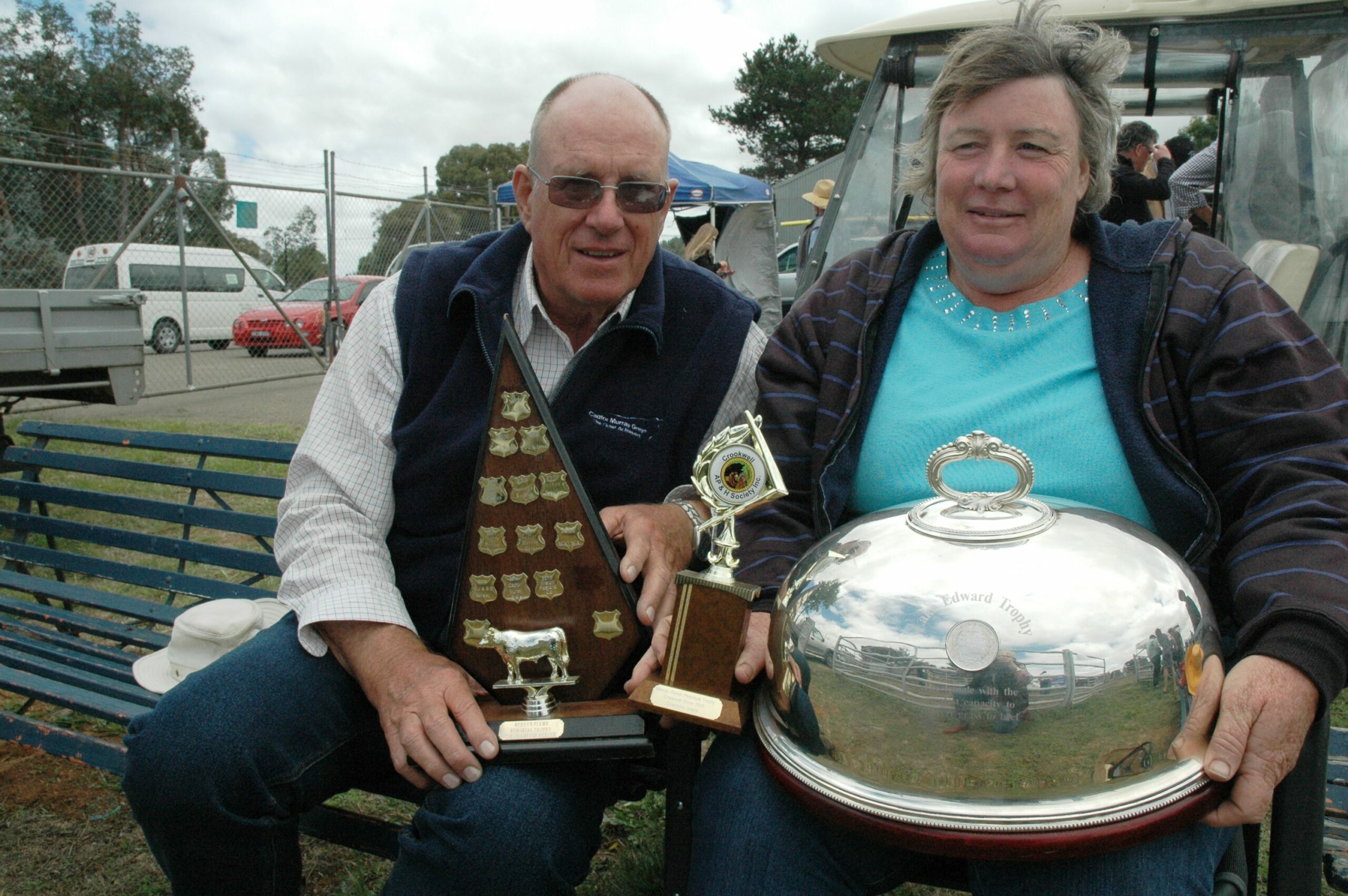
Quarry
Early in their ownership of Binda, Rod and Helena were given advice to look for a site for a quarry to provide gravel for road and yards as they were told by numerous locals that Cadfor was a ‘wet block’. When the bulldozer was digging dams they took the opportunity to open up a quarry site on the top of the hill which is on a quartz seam. This quarry has been used extensively over the years and saved them a lot of money. All weather roads from the front gate to the cattle yards, as well as tracks throughout the property and 20 x 20 metre feeding pads on the inside of paddock gates have been gravelled. Their house is built on a slope so rather than doing a cut and fill, they built it on a pad of about one metre of quartz rock and gravel.
Energy usage
A 10 Kw solar voltaic system was installed in 2011 which generates twice as much electricity as normally used. The excess electricity is returned to the grid and a feed-in-tariff is received. Since the solar panel installation, the Cadfor electricity accounts have always been in credit. Maximum use is made of solar generation by using time switches to operate functions such as hot water heaters, freezers, refrigerators and water pumps filling tanks and troughs.
Erosion rehabilitation
Binda Vale Creek
Binda Vale Creek is highly eroded before it enters Cadfor, and judging from aerial photos has been so for many decades. To control the erosion the Soil Conservation Service erected a large dam on the creek about 200 metres inside Rod and Helena’s neighbour’s property and, in so doing, diverted the creek flow through the boundary fence and via a contour bank, directed it into the large dam in front of their house. With periods of high rainfall, the flow from the large Binda Vale catchment exceeded the contour bank capacity and water flowing over the bank exacerbated erosion along the creek banks.
Consultation with Local Land Services staff and contractors recommended constructing a new channel to divert the water from inside the boundary to a new rock rundown, taking the creek flow into the bottom of the creek bed. A grant was obtained from the Australian River Restoration Centre’s Rivers of Carbon Program to carry out the remediation. This work was carried out in 2020, but a heavy flow in spring 2020 led to the failure of the rock rundown. The rundown was completely rebuilt in January 2021.
Chain of Ponds Creek
The original map of land granted to Charles Hone had “Chain of Ponds” marked where the eroded gully was located. The Chain of Ponds had been drained by the Hone family some hundred years ago to allow them to grow wheat. Over time, the drains became eroded and the creek became a single highly eroded gully, with only two of the original ponds retaining any water after creek flow. In 2006, after Rod and Helena purchased the block, they enquired about rehabilitating the gully. They were advised that the steep sided gully was a 3rd order creek and so could not be touched. Instead, the couple constructed three ‘leaky weirs’ to allow the gully to be crossed by livestock and vehicles.
After an inspection by Craig Sponholtz, an application was made by Landcare to rehabilitate the gully, so that the chain-of-ponds could be reinstalled and the floodplain rehydrated. The application was successful, and remediation was carried out by Campbell Wilson in 2016. There are now about 14 ponds in the Cadfor section of the Chain of Ponds Creek.

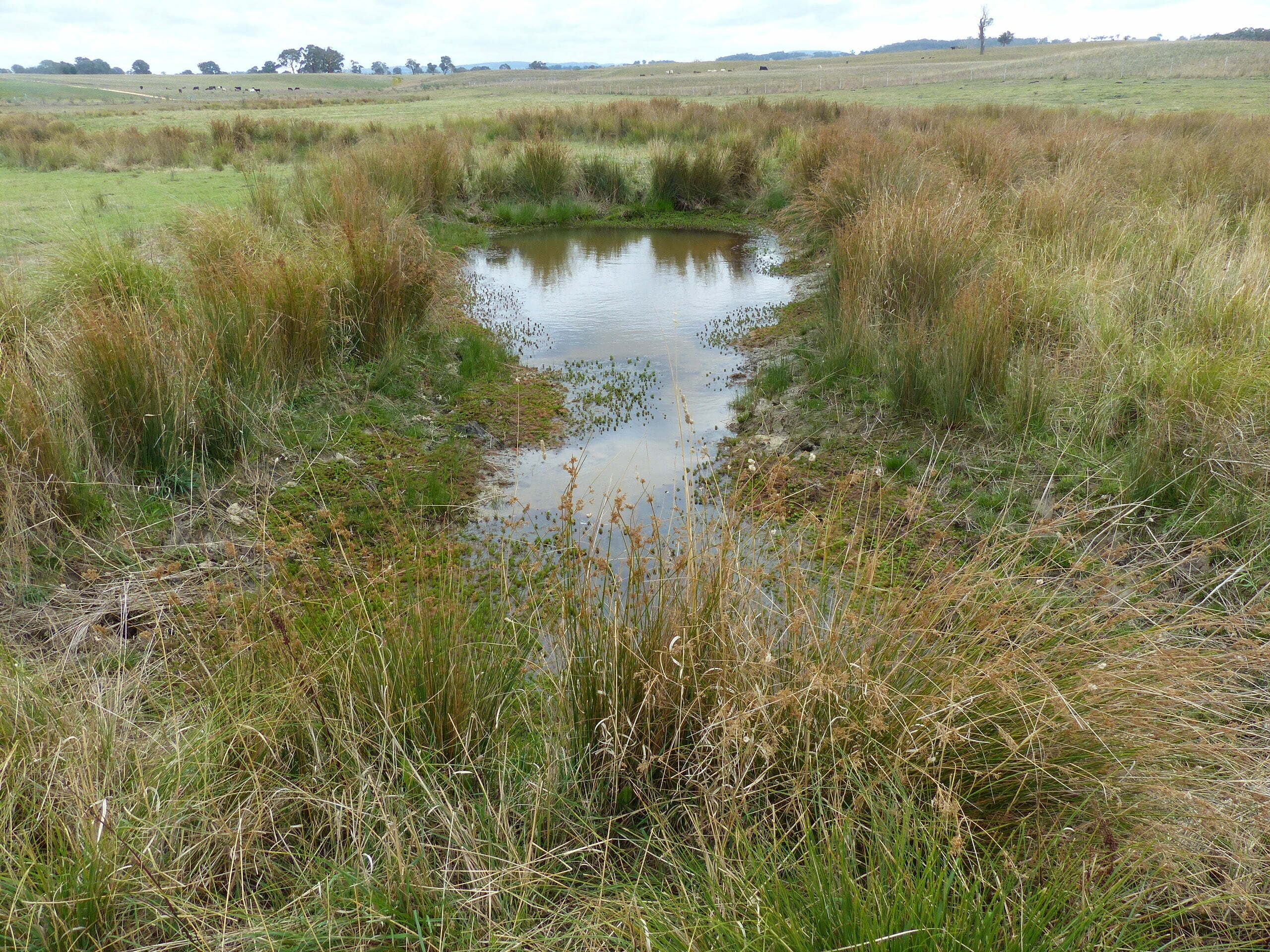
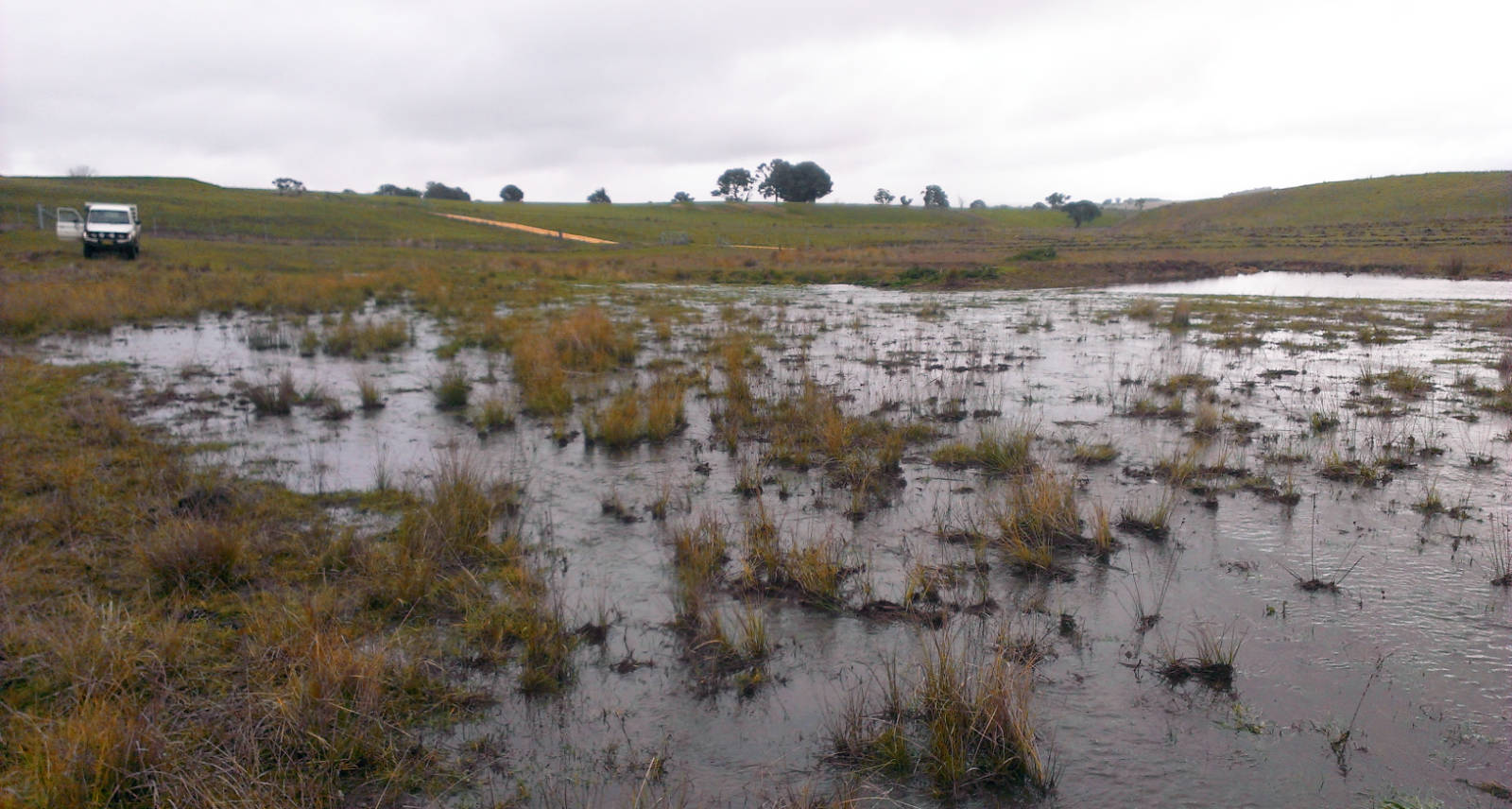
Wildlife
Kangaroos and wallabies are not resident on the property because the heavy tree cover they prefer is not available. Sometimes kangaroos can be a nuisance because they break or short the electric fences. Wombats are resident. They do not cause as much nuisance on a cattle property as they do to sheep fencing. Echidnas are commonly seen and twenty four of their sightings have been reported to Echidna CSI.
A Rakali and its middens have been sighted on the Chain of Ponds Creek. Since the drought it has not been sighted unfortunately.
Helena and Rod love the birds on the property but they are not twitchers or ornithologists. There are numerous water birds on the dam in front of the house. They have made frequent sightings of a solitary Leyton’s Snipe in the wetlands near the house. There are many frogs in the creeks, dams and springs on the property. They made numerous recordings on the FrogID App and identified 15 species of frogs.
Collaborating with others
Rod and Helena have always been open to collaborating with others and over the years have undertaken projects with:
- Greening Australia
- Lachlan Catchment Management Authority
- Landcare
- Australian River Restoration Centre
- Kanangra to Wyangala (K2W) Partnership
Many of these project collaborations have focused on attaining environmental and productivity benefits. Rod and Helena are very grateful for the assistance that these organisations have provided.
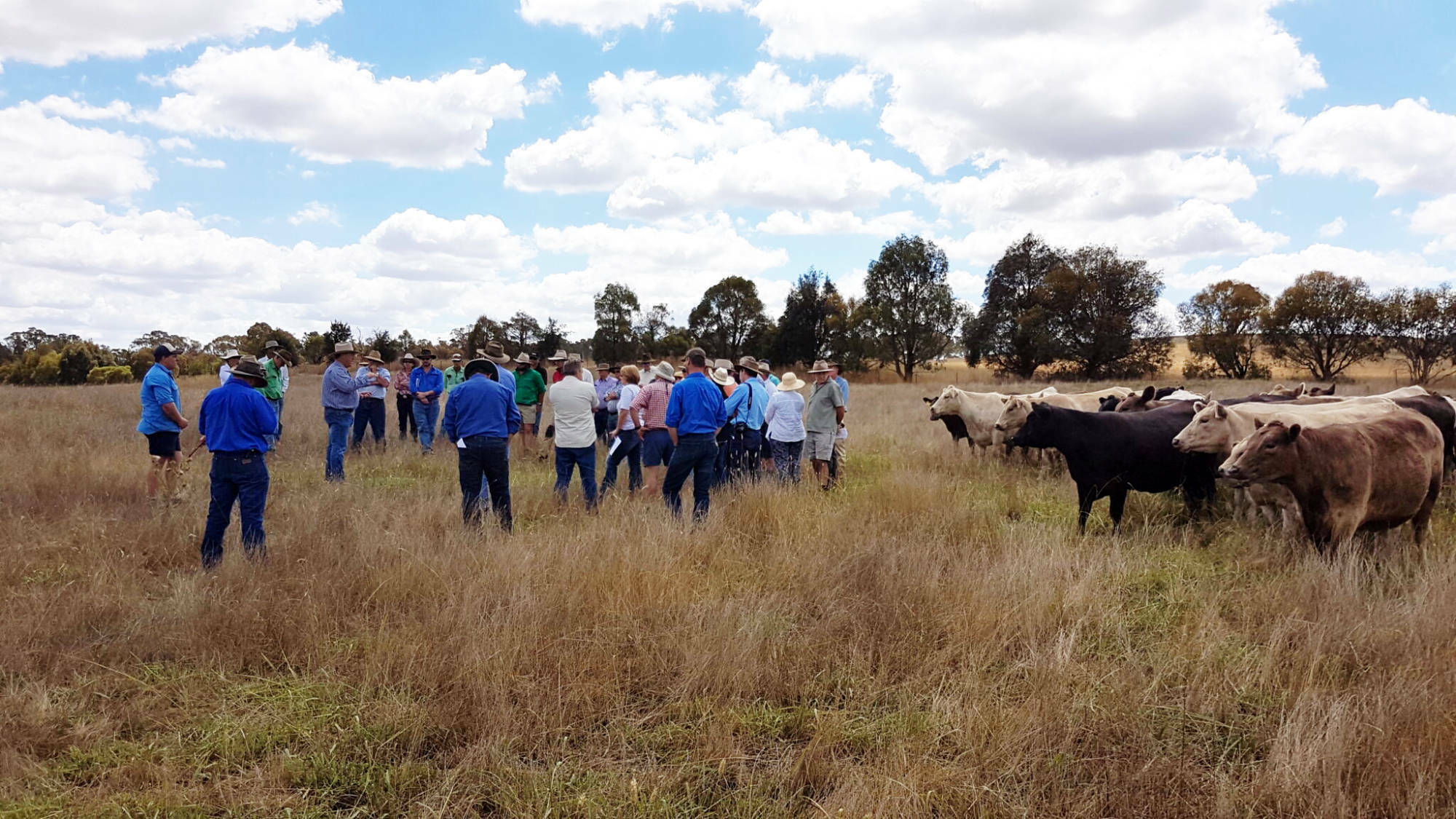
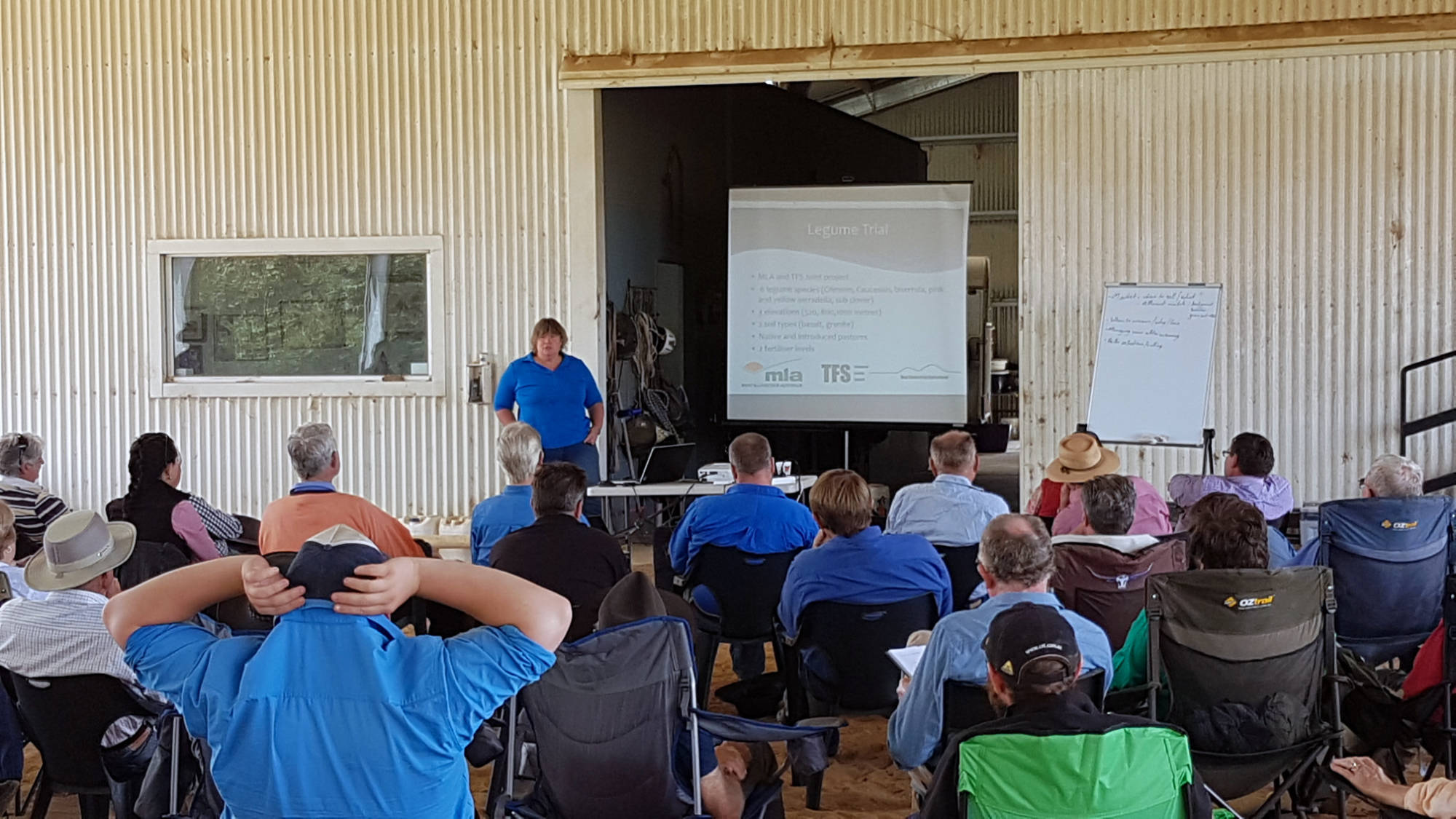

“Cadfor” – a place of learning
“Cadfor” is named after Rod’s mother’s birthplace in Wales where the family still farm. When the couple bought and named ‘Cadfor’, a numerology test on the name said that it meant “A Place of Learning”. Rod and Helena quite liked that because it was to be an Equestrian Centre and they wanted to demonstrate good agricultural practices in their farm development.
A purpose built covered arena, including stables and a seminar room is now used for information days and equestrian clinics covering dressage, show jumping and cross country. Stud cattle Open Days and Information Days with a focus on cattle management have also been run on the property.
Good agricultural practices are promoted at seminars, field days and pasture walks hosted by NSW DPI, Local Lands Services, Upper Lachlan Landcare, Tablelands Farming Systems and NSW Grassland Society. Erosion control and flood plan rehydration have also been the subjects of formal and informal inspections of their Chain of Ponds restoration and flood plain rehydration. ‘Cadfor’ is indeed a place of learning.
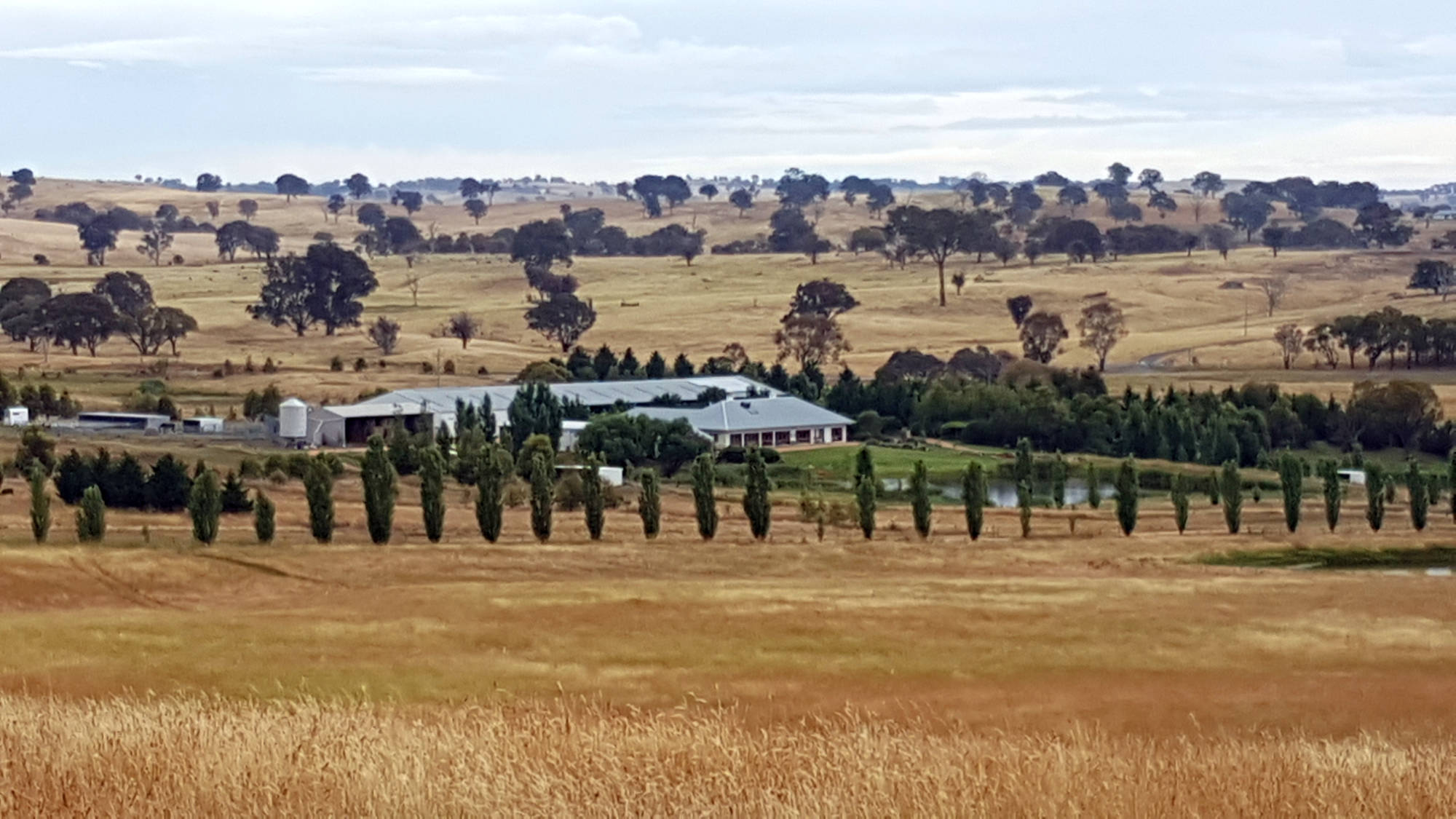
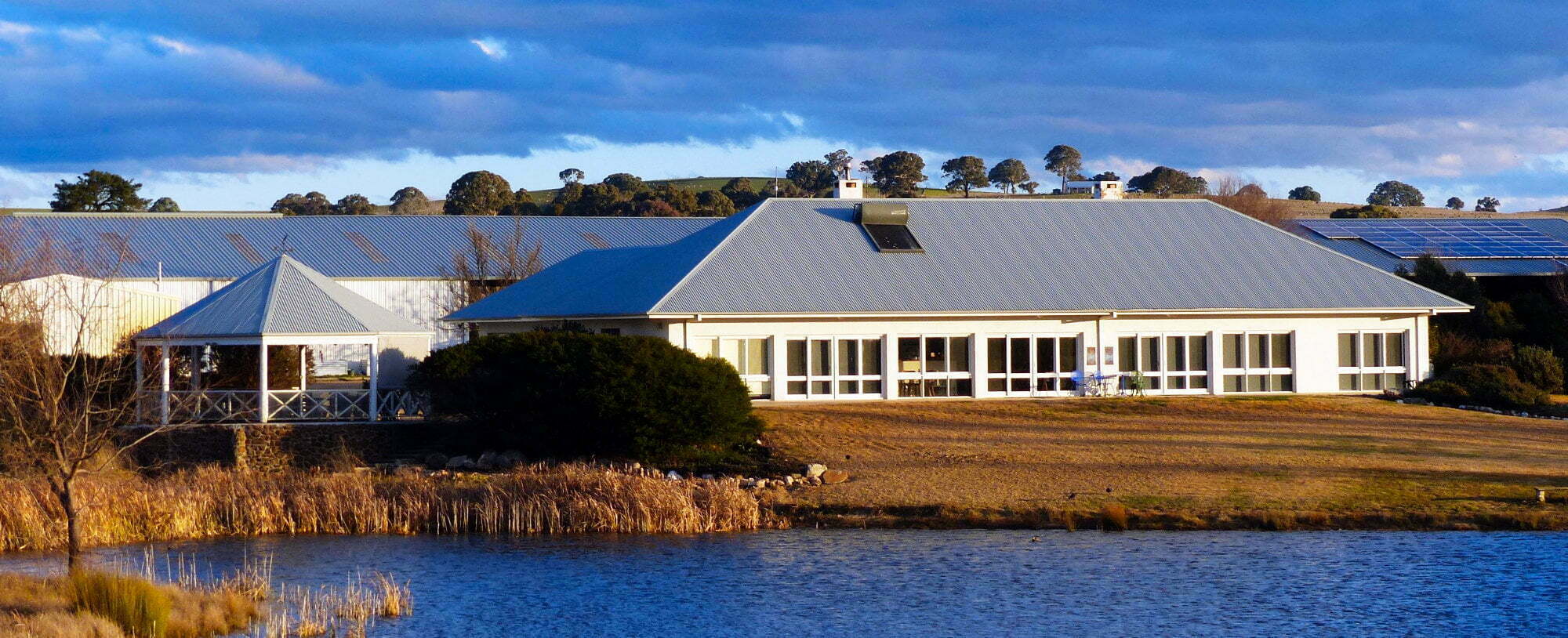

All photos and images supplied by Rod Hoare and Helena Warren and with our heartfelt thanks to them for sharing their ‘Cadfor’ story.
